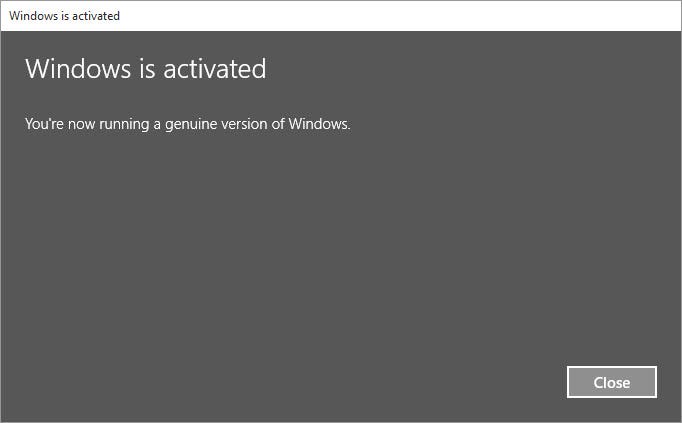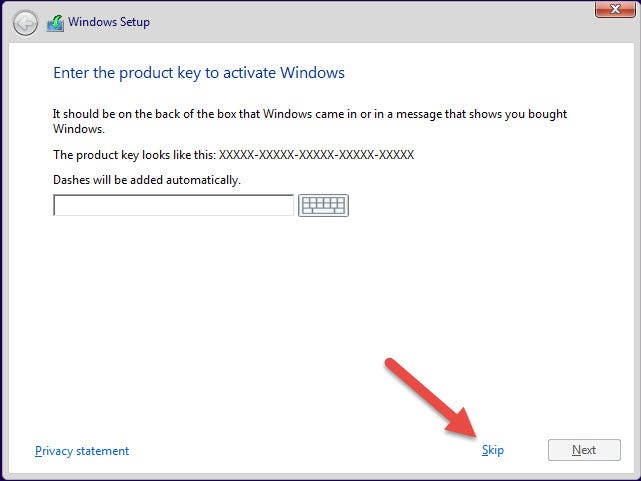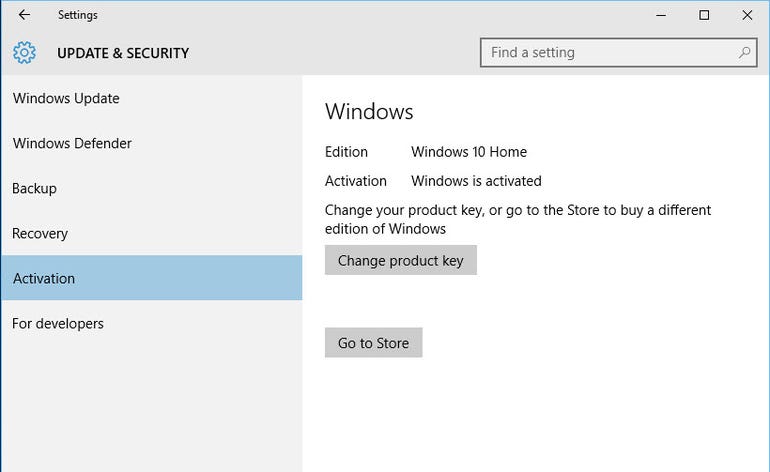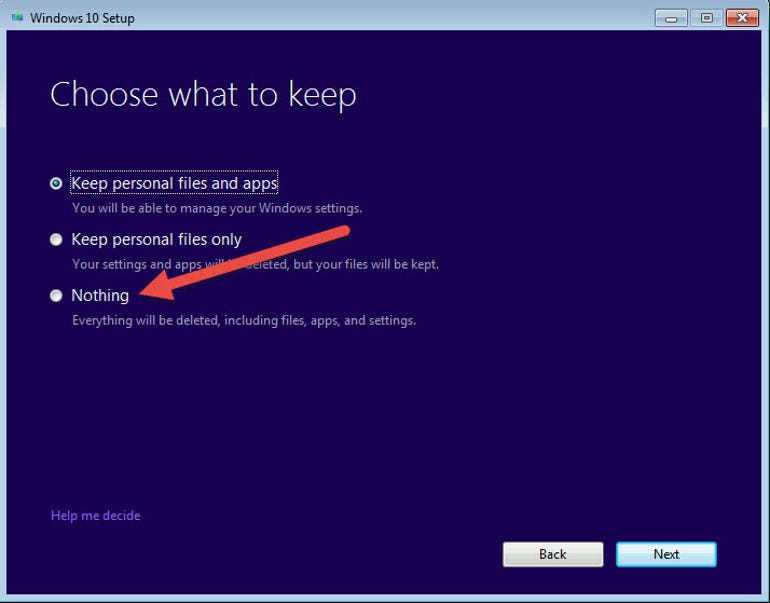Windows 10 I Want to Activate Windows Office Try Again Later
Windows production keys are almost (but not quite) a thing of the past.
With Windows 10, Microsoft has rewritten the rules for how it performs product activation on retail upgrades of Windows, including the free upgrades available for a yr starting time on July 29, 2015. The net outcome is that make clean installs will be much easier--only only after you get past the first 1.

OEM activation hasn't changed, nor have the procedures for activating book license copies. But the massive Become Windows ten upgrade button ways that for the near future at to the lowest degree those retail upgrade scenarios are very of import.
The biggest change of all is that the Windows ten activation status for a device is stored online. After yous successfully actuate Windows x for the start time, that device volition actuate automatically in the futurity, with no product key required.
That'southward a huge modify from previous versions of Windows, which required a product cardinal for every installation. And it'due south potentially an unwelcome surprise for anyone who tries to practise a make clean install of Windows 10 without understanding the new activation landscape.
Microsoft is characteristically shy most discussing the details of activation. That's understandable, because every detail the company provides about its anti-piracy measures offers data that its attackers can apply.
Simply it's also frustrating, because Microsoft'south customers who apply Windows don't want to have to think about activation. The Windows PC yous paid for, and the costless upgrade y'all spent fourth dimension installing, should just work.
I've had some manner-off-the-record discussions with people who know a few things most the subject, and I've also done my own testing for the ii weeks since Windows ten was released to the public. Here'southward what I've learned.
Your Windows ten license is stored online and linked to your device.
For more than a decade, ane of the keys that Microsoft's activation servers take relied on is a unique ID, which is based on a hash of your hardware. That hash is reportedly not reversible and not tied to any other Microsoft services. So although it defines your device, it doesn't place you.
Here'due south how that ID works with Windows 7 or Windows 8:
When you activate for the first time, that hashed value (permit's phone call it your installation ID) is recorded in the activation database alongside the product key you entered with the installation. Later, when you reinstall the aforementioned edition of Windows on the same hardware, with the aforementioned product key, it'southward activated automatically. (Conversely, if you try to use that product key on a dissimilar machine with a different hardware ID, you'll probably be denied activation.)
**Several people have asked nearly hardware upgrades. See update at the end of this mail service.
Windows 10 goes one very large step further.
When y'all upgrade from Windows vii or Windows eight.1, the Windows 10 setup program checks your current activation status and reports the result to the activation servers. If you're "18-carat" (that is, properly activated), the Windows activation server generates a Windows ten license certificate (Microsoft calls information technology a "digital entitlement") and stores it in conjunction with your installation ID and the version y'all just activated (Abode or Pro).
It didn't need a product key to practise that activation. All information technology needed was the proof from the Software Licensing Manager utility that your underlying activation was legit.
You tin now wipe that hard disk completely, boot from Windows x installation media, and install a squeaky clean re-create.
The Setup programme asks you to enter a product central, but in a major change from Windows 8 and viii.1, information technology allows you lot to skip entering that key.

Yous'll exist asked to enter that central a second time, subsequently in setup, but you lot can skip past that box as well. When you finish the reinstall, assuming y'all used the same Windows ten version on that hardware, you'll find it's automatically activated.
I've tested this scenario on multiple machines, and the result has been consistent:
Step i: I booted from Windows 10 installation media, a USB flash bulldoze prepared by the Windows 10 Media Creation tool, and tried a clean install on a organization that had never been activated for Windows x. I skipped both prompts to enter a product cardinal. Result? My system failed activation.
Step 2: I reset the machine with its original, activated copy of Windows 7 or Windows viii.1 and then ran the Windows 10 online upgrade. At the finish of the process, I confirmed that Windows 10 was properly activated.

Footstep 3: I then wiped the hard bulldoze make clean and used the verbal same media every bit in Pace 1 to do a clean install of Windows ten. As earlier, I skipped the production fundamental entry. I used a Microsoft account in 1 test and used a local account in some other. Subsequently the installation was complete, the system showed that it had a properly activated re-create of Windows 10.
You can, of course, buy a total or OEM copy of Windows 10 on a flash drive, and you tin can also buy product keys online. Yous tin use that product key to practice a clean install on a system that has never run Windows ten and it will get a license certificate from the activation servers. And but like those upgraded PC, it should then allow you to do a clean install of the same Windows x edition without having to re-enter the product key.
For those who are anxious to do a clean install, here's the flim-flam:
Don't practice the online upgrade.
Instead, from your current, activated copy of Windows 7 or Windows 8.1, download the Windows x ISO file for the corresponding edition (Home or Pro), or create a bootable USB flash bulldoze. Without exiting your current Windows version, double-click the ISO to mount information technology as a virtual DVD (or open the USB flash drive with installation media) and then double-click Setup.
Your goal is to get to the screen with this full range of options:

Cull the choice I've highlighted at the bottom: the one that says you want to proceed nothing. The Windows 10 Setup plan installs a clean copy of the edition that corresponds to the 1 you have installed. As office of the process, it verifies the activation condition of your erstwhile Windows, creates the new license document, and blows away your previous install. And yous never had to enter a production cardinal.
After you restart, your clean copy of Windows 10 is activated, and yous can reinstall it any time without having to worry about activation. And you'll never need a product key once more.
That's all well and good for those who are currently running Windows 7 or Windows 8.1. Just what about those who did a clean install of a preview edition, never upgrading over a licensed copy?
Sorry. Yous can skip the product key during installation, simply when y'all're done with Setup your system volition be marked every bit non activated. You won't be able to utilize any personalization options, and you'll have a persistent watermark on the desktop warning you that you need to activate.
To "get 18-carat," you're going to need to do one of two things: go a Windows ten product primal for the edition you have installed (you can apply a key from MSDN or a retail source) or restore your old operating organization, actuate it, and so do the upgrade to register a license document.
I honestly accept no idea how the telephone activation hotlines volition respond to calls from Insiders who want to activate a re-create for the first fourth dimension. This is new territory for Microsoft and for its customers.
Update: In the comments, several people have asked what happens if you lot make changes to hardware. As I noted earlier, Microsoft doesn't provide details of how it calculates that hardware hash, only upgrades of system components such equally a video card or a hard drive won't unremarkably trigger a reactivation. If that happens, a quick call to the activation line will resolve the consequence, often without whatever human contact required, in minutes.
The one exception is a motherboard replacement, which volition inevitably crusade the Software Licensing Management utility to recognize the device as a new PC and require reactivation, typically over the phone. A motherboard upgrade, even if you reuse storage, video, retentiveness, and a case, is considered a new PC. In that case, if the underlying Windows license is from a retail copy, that license can be transferred. If you are upgrading (and non replacing) a motherboard on an OEM PC that was sold with Windows preinstalled, the license agreement prevents the license from beingness transferred.
Source: https://www.zdnet.com/article/microsoft-quietly-rewrites-its-activation-rules-for-windows-10/
